Functionalization of boron-doped diamond with a push-pull chromophore via Sonogashira and CuAAC chemistry
- PMID: 35548149
- PMCID: PMC9086440
- DOI: 10.1039/c8ra07545j
Functionalization of boron-doped diamond with a push-pull chromophore via Sonogashira and CuAAC chemistry
Abstract
Improving the performance of p-type photoelectrodes represents a key challenge toward significant advancement in the field of tandem dye-sensitized solar cells. Herein, we demonstrate the application of boron-doped nanocrystalline diamond (B:NCD) thin films, covalently functionalized with a dithienopyrrole-benzothiadiazole push-pull chromophore, as alternative photocathodes. First, a primary functional handle is introduced on H-terminated diamond via electrochemical diazonium grafting. Afterwards, Sonogashira cross-coupling and Cu(i) catalyzed azide-alkyne cycloaddition (CuAAC) reactions are employed to attach the chromophore, enabling the comparison of the degree of surface functionalization and the importance of the employed linker at the diamond-dye interface. X-ray photoelectron spectroscopy shows that surface functionalization via CuAAC results in a slightly higher chromophore coverage compared to the Sonogashira cross-coupling. However, photocurrents and photovoltages, obtained by photoelectrochemical and Kelvin probe measurements, are approximately three times larger on photocathodes functionalized via Sonogashira cross-coupling. Surface functionalization via Sonogashira cross-coupling is thus considered the preferential method for the development of diamond-based hybrid photovoltaics.
This journal is © The Royal Society of Chemistry.
Conflict of interest statement
There are no conflicts of interest.
Figures
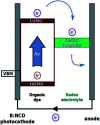


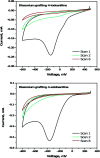
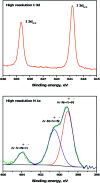




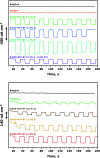
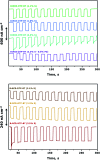
Similar articles
-
Functionalization of boron-doped nanocrystalline diamond with N3 dye molecules.ACS Appl Mater Interfaces. 2014 Jul 9;6(13):10322-9. doi: 10.1021/am501783b. Epub 2014 Jun 23. ACS Appl Mater Interfaces. 2014. PMID: 24915549
-
Monolayer Doping of Si with Improved Oxidation Resistance.ACS Appl Mater Interfaces. 2016 Feb 17;8(6):4101-8. doi: 10.1021/acsami.5b11731. Epub 2016 Feb 4. ACS Appl Mater Interfaces. 2016. PMID: 26812170
-
Doping Level of Boron-Doped Diamond Electrodes Controls the Grafting Density of Functional Groups for DNA Assays.ACS Appl Mater Interfaces. 2015 Sep 2;7(34):18949-56. doi: 10.1021/acsami.5b06394. Epub 2015 Aug 21. ACS Appl Mater Interfaces. 2015. PMID: 26285076
-
Diamond and biology.J R Soc Interface. 2007 Jun 22;4(14):439-61. doi: 10.1098/rsif.2006.0196. J R Soc Interface. 2007. PMID: 17251162 Free PMC article. Review.
-
Boron-doped diamond electrode: synthesis, characterization, functionalization and analytical applications.Analyst. 2009 Oct;134(10):1965-79. doi: 10.1039/b910206j. Epub 2009 Aug 7. Analyst. 2009. PMID: 19768202 Review.
Cited by
-
Self-Assembled Monolayers of Push-Pull Chromophores as Active Layers and Their Applications.Molecules. 2024 Jan 23;29(3):559. doi: 10.3390/molecules29030559. Molecules. 2024. PMID: 38338304 Free PMC article. Review.
References
LinkOut - more resources
Full Text Sources

